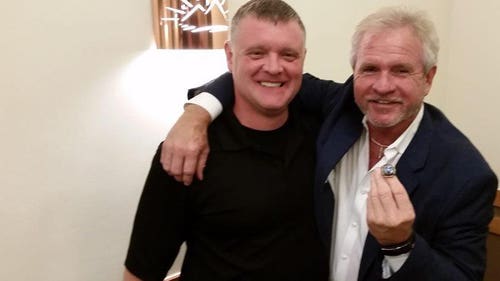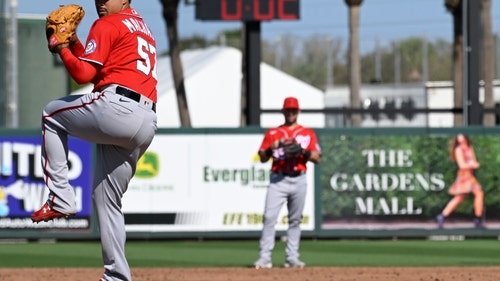
Rangers performing despite ownership fiasco
The Angels should be embarrassed if the A’s or Rangers win the AL West. Frankly, the Mariners should be, too.
The A’s are in low-revenue prison at McAfee Coliseum. The Rangers are in a different kind of prison, awaiting new ownership. Yet the Rangers lead the AL West and the A's are just a game back after Sunday.
The sale of the club, which began after Rangers owner Tom Hicks defaulted on $525 million of debt in March 2009, restricted the team in last year’s amateur draft as well at the trade deadline and during the offseason.
The same thing could happen again.
According to the Sports Business Journal, MLB could seize the Rangers and complete the sale to a group led by Chuck Greenberg and Nolan Ryan in an attempt to evade the standoff between Hicks and his creditors. Such a move could prompt the creditors to take legal action, including an involuntary bankruptcy petition.
Lovely.
The best resolution for the Rangers, and probably for everyone else, would be for Hicks and his creditors to resolve the reported $30 million gap in their respective proposals and be done with this already.
The team certainly has suffered enough.
The Rangers lost any chance to land right-hander Roy Halladay last July when the pitcher told the Blue Jays he would not waive his no-trade clause for Texas.
But at the time, some with the Blue Jays thought the deal had no chance to begin with, believing that MLB, which was helping finance the Rangers, would not have allowed the team to take on Halladay’s contract.
The Rangers would have needed the Jays to pay at least part of Halladay’s salary. Such an exchange would have required them to give up better prospects — left-hander Derek Holland and first baseman Justin Smoak. Club officials were reluctant to make such a deal, but Halladay made their decision for them.
In the draft, MLB gave the Rangers clearance to go above slot for their first-round choice, high-school left-hander Matthew Purke. The Rangers, according to a source, offered Purke $4 million. But team president Nolan Ryan later said publicly that the team had agreed to a pre-draft deal with Purke for $6 million. MLB, which by then was involved with the team’s operation, would not approve the signing at that number.
The Rangers then needed to perform financial gymnastics in an effort to improve during the offseason, trading right-hander Kevin Millwood, for example, to clear money for free-agent righty Rich Harden.
An MLB takeover would last only until the completion of the sale, which would happen quickly only in theory. MLB, according to a source with knowledge of baseball’s thinking, would ask Ryan to stay in place and operate the club the way it operated the Montreal Expos. The Rangers have a budget; MLB would expect them to follow it.
“It would not be awful,” the source said.
It also would not be as good as an immediate sale to the Greenberg-Ryan group, but the standoff between Hicks and his creditors has lasted nearly four months.
Hicks created one big mess.
MISSING SWISH
The White Sox sure could use a left-handed hitting first baseman who would enable them to move Paul Konerko to DH.
Too bad they no longer have Nick Swisher.
The White Sox gave up a significant package to get Swisher from the A’s in January 2008: left-hander Gio Gonzalez, outfielder Ryan Sweeney and minor-league pitcher Fautino de los Santos.
Swisher, a switch hitter, hit 24 homers in his only season with the Sox, but had a career-low .743 OPS and rocky relationship with Manager Ozzie Guillen.
When the Sox traded Swisher and reliever Kanekoa Texeira to the Yankees at the end of the season, they received only infielder Wilson Betemit and minor-league right-handers Jeff Marquez and Jhonny Nunez in return.
The series of transactions obviously did not turn out well for the Sox.
SAY-HEY URIBE
Giants manager Bruce Bochy is serious about keeping infielder Juan Uribe in his lineup even after second baseman Freddy Sanchez returns from surgery on his left shoulder.
“He’s a ‘money’ player,” Bochy says of Uribe. “Look what he did for the White Sox in the (2005) World Series, how it ended with that tough play" — Uribe flawlessly fielding a slow roller for the final out.
"He’s a better hitter now than he’s ever been, more disciplined — the type of hitter we need, someone who can do some damage.
“He drives in runs. He hits the ball out of the ballpark. And the guy has fun playing the game. He walks in the clubhouse with a big smile on his face. He helps keep everyone loose. He’s probably the most popular guy on the team.”
Bochy says he can play Uribe at second base, shortstop and even third, occasionally shifting Pablo Sandoval to first.
Uribe, 31, drew a career-high four walks and was hit by a pitch Sunday, but he will never be an on-base machine — his career OBP is .300. Still, he leads the Giants with 20 RBIs.
FRANCONA: TRYING TO MANAGE
Among other things, Red Sox manager Terry Francona is dealing with an inflexible roster as the team carries two designated hitters and awaits the returns of injured outfielders Jacoby Ellsbury and Mike Cameron.
When Francona starts Bill Hall in left field, he occasionally uses Jeremy Hermida to replace him. The substitution leaves the Red Sox without a backup infielder.
The one difficult situation from which Francona says he “derives some enjoyment” is the way his pitchers and catchers have rallied around each other trying to thwart the opponents’ running game.
The Red Sox haven’t exactly fixed the problem — opponents are 44 for 49. But catchers Victor Martinez and Jason Varitek, in particular, have formed a rare bond, warming each other up before games.
Martinez works diligently on his throwing even between innings, simulating a game situation on his throw down to second. Varitek studies him from the dugout, and the Red Sox inform Martinez of his release time when the inning is over.
The Indians signed Martinez as a shortstop in 1996, then converted him to catcher in ’97. Martinez retains a special humility about the position, taking nothing for granted.
“I remember when they moved me behind the plate. They told me to give it a try, see what happens,” Martinez says. “Here I am, still giving it a try.”
GIRARDI: A REGULAR JOE
On Friday, I rode the Acela from New York to Boston, working on my laptop the entire trip. About an hour into the journey, I looked up and there was Yankees manager Joe Girardi, saying hello.
The Acela is Amtrak’s faster, more expensive train, but Girardi rode in business class, not first class. The Yankees had left for Boston the previous day, but Girardi spent an extra night in New York to be with his family.
Girardi, 45, said he accompanied his 3-year-old daughter, Lena, to her tennis lesson, took his 9-year-old son, Dante, to baseball practice and helped his 10-year-old daughter, Serena, prepare for a math test on probability.
A few people said hello to him on the train, but he was pretty much left alone.
MEMORIES OF ERNIE
Growing up in Corruna, Ontario, Yankees third base coach Rob Thomson would play cribbage with his father, Jack, while listening to Ernie Harwell’s Tigers broadcast on the radio.
Thomson summoned those memories of those times when a newspaper in Ontario profiled him in 2008. Harwell learned of the article and decided to write about Thomson for his own column in the Detroit Free Press; Thomson actually had been drafted by the Tigers as a catcher in 1985.
Needless to say, Thomson recalls the interview fondly. He says he doesn’t go “ga-ga” over celebrities — smart thinking for someone who works for the Yankees — but Harwell was different.
“As soon as he picked up the phone,” Thomson says, “I knew it was him.”
FOR CC, FAMILIARITY BREEDS SUCCESS
One difference for CC Sabathia in his second season with the Yankees is that pitching coach Dave Eiland knows him better than he did a year ago.
When Sabathia gets into a familiar mechanical rut, collapsing on his back leg, then rotating and overstriding, Eiland picks up on it immediately. He’ll make a hand gesture to Sabathia from the dugout, reminding him to stand tall.
Sabathia had a 2.74 ERA through six starts, his best beginning to a season since 2006. He had a 4.85 ERA through six starts last season.
A NEW PERSPECTIVE ON D-BACKS’ KENNEDY
Maybe Yankees general manager Brian Cashman was right about right-hander Ian Kennedy, who was the team’s first-round pick and 21st overall selection in the 2006 draft.
Cashman repeatedly defended Kennedy before sending him to the Diamondbacks last winter in the three-team trade that brought center fielder Curtis Granderson to the Yankees.
Scouts generally disparage Kennedy, but at least one has changed his opinion now that the Kennedy is in the more pitcher-friendly National League.
“I respect the way he pitches,” the scout says. “He knows what he’s doing. He’s a guy I wouldn’t mind having.
“I don’t know if I’d call him finesse. He’s 88 to 90 (mph) and he attacks with his fastball, which is what you want to do. It’s impressive. I’d still put him in as a fourth starter, but he’ll be a steady guy, a Rick Reed type.”
Reed went 93-76 with a 4.03 ERA in a major-league career that spanned 15 seasons. Kennedy, 25, is 2-1 with a 3.65 ERA in six starts for the Diamondbacks.
JUST A THOUGHT: BUCK IN BALTIMORE
How about Buck Showalter as the eventual replacement for Orioles manager Dave Trembley?
Yankees first baseman Mark Teixeira says that Showalter, his former manager with the Rangers, alleviates the fears of young players.
“He is great for young players,” Teixeira says. “He lets you know that young guys are going to have ups and downs. He understands how tough it is to play this game.”










